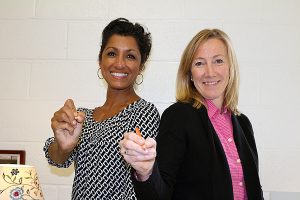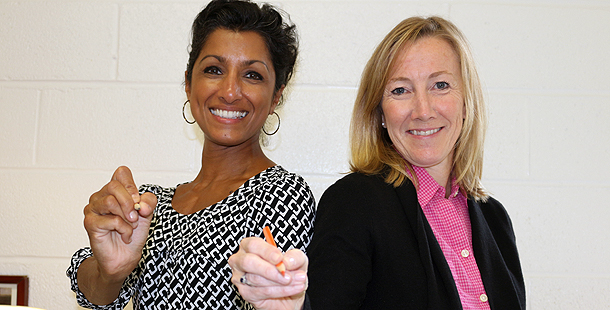
WRITE OR WRONG: Maria Montessori School teachers Stephanie Roughton, left, and Anindita Plock still teach cursive writing even though it is no longer mandatory in Ontario curriculum.
Is the art of cursive writing dead?
The writing isn’t on the wall just yet for the art of cursive writing.
As digital technology depletes the necessity of using a pen, schools are trying to adapt to help their kids succeed
in today’s world.
Many educational facilities throughout midtown Toronto are not wanting to retire their ballpoints just yet — at least until they know the long-term effects.
The Linden School, an all-girls roost situated near Yonge Street and St. Clair Avenue East, whose students come from varying backgrounds, is watching the trends closely.
Beth Alexander, a core teacher who specializes in keyboarding at Linden, says it’s an interesting time to be a teacher, with plenty of research being done on the effects of limited cursive teaching in class.
Linden hasn’t stopped teaching handwriting, but the daylong classes are long gone, as the focus shifts to keyboarding.
“We don’t know yet what not having a lot of cursive does to students in terms of their brain development or their skill development in ways not related to cursive,” she says. “It’s something we’re keeping our eye on.
“Things are changing quickly and we’re not sure how it will shake out.”
In her 10 years at Linden, Alexander has seen parents shift their concern from cursive to keyboard safety and how to avoid repetitive stress woes.
“An argument I am hearing is cursive is quick when you’re taking notes in university,” she said, adding other parents express their thoughts only on the loss of an art form. “Interestingly, our senior art teacher has the kids practice cursive and drawing.”
Some of the students who end up at Linden come from schools like Maria Montessori, which introduces its kids to the basics of cursive writing at age 3½.
Jim Brand, principal at the North Leaside school, says he is a strong supporter of cursive in the classroom. It is important to expose kids to it as early as possible, he believes.
“The main thing is, when you’re writing it’s a part of the development of your hands and the development we, as human beings, associate with things,” he says, “The flow of cursive writing is in keeping with our own nature.
“You don’t have to keep taking your hand off the paper and you’re not artificially developing these shapes. You’re actually developing the flow.”
For Brand, it’s not about the inability of signing one’s John Hancock, but more about developing hand-eye coordination, as well as stimulating a child’s creativity.
“Give a child a piece of paper and a pencil and they don’t make rigid, straight up-and-down shapes,” he says, his voice bubbling with enthusiasm. “They make flowing coils and things like that.”
Over at Crescent School, in the Bayview and Lawrence area, handwriting is far from being lost in historical texts.
Margot Beech-Kennedy, head of student services for the lower and middle schools, says it is status quo when it comes to cursive in her neck of the woods.
“There are lots of places where cursive still shows up in day-to-day life even though we’re becoming more technological,” she says, adding they’re keeping their students grounded in both the paper and the digital world.
Like Linden, Crescent teaches handwriting in Grade 3. They continue the process through Grade 4 and then mandate that certain projects in Grade 5 and Grade 6 be written in cursive.
She laughs at the tongue-in-cheek question of whether students who under-perform in handwriting become doctors, but adds they accommodate all means of communicating the English language.
“What I also see in our boys, some are very successful in using cursive and that’s a really excellent way for them to express their thoughts on paper,” she says. “Some are more adept at using their laptops, and some still prefer to print — even into the upper grades — and we try and provide our boys with whatever means they need to be successful.”
Still, there is no impetus to change the curriculum at Crescent when it comes to handwriting.
One young-at-heart spirit who doesn’t want to see cursive go the way of the inkwell is writer and graphic designer Abigail Lee.
The 32-year-old has hand-written a children’s book called Some Bunny Loves You! Available at local bookstores and on Amazon, Lee’s book shares the adventures of a young girl and her pet bunny as they travel the world.
Her perspective on the cursive writing debate centres more on giving the brain a full-body workout, in this digital age where “people are just texting.”
“It’s wonderful, but it only improves half of the brain,” she says, with childlike fascination, “whereas the handeye coordination and motor skills actually get developed by handwriting — both right and left hemispheres of the brain.”
Her love of handwriting led her down a creative career path. During her honour roll year at York University, Disney came calling to recruit her for her graphic design services.
Lee travelled the world for the famous cartoon company, and the inspiration for Some Bunny was born.
All the artwork was done while she lived in California, before the North York-born Lee moved back to the Greater Toronto Area to publish with Miracle Press. The initial plan was to give the book to orphans in the varying countries she had visited.
“I wanted to be able to translate my book and personally go and give it to the orphans, and tell them, somebody does love them, in their language,” she says, adding the book has been translated into Korean, Japanese, Chinese, French, Spanish and even Haitian Creole.
“It was something I wanted to do, to capture such a historical passion and also to be able to deliver that to the children now,” she says.
The curriculum at these midtown schools reflects a steady-as-she-goes approach when it comes to handwriting versus printing or the digital world.
Maria Montessori’s Brand crosses his Ts and dots his lower-case Js with his response to the question of what he tells parents who balk at the practicality of handwriting.
“I would say, ‘Okay, if you take that stance, then get rid of art and phys-ed, do all of your stuff on an iPad and forget about the other aspects’,”
he said. We need to teach cursive writing, he says, “if we want to be well-rounded human beings, who aren’t captive and dependent on technology.”

